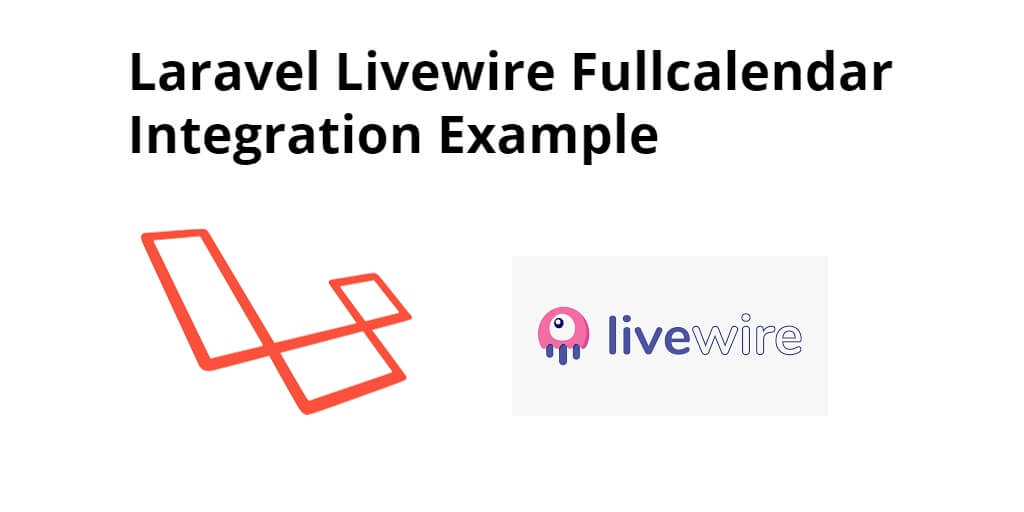Laravel 8 livewire fullcalendar integration example. In this tutorial, you will learn how to integrate fullcalendar in laravel app with the livewire.
This tutorial will guide you step by step on how to integrate fullcalendar in laravel app with the livewire.
Laravel Livewire Fullcalendar Integration Example Tutorial
Follow the following steps and integrate fullcalendar in laravel app with livewire:
- Step 1: Install Laravel 8 App
- Step 2: Add Database Detail
- Step 3: Install Livewire Package
- Step 4: Create FullCalendar Component using Artisan
- Step 5: Add Route For Livewire FullCalendar
- Step 6: Add Code On View File
- Step 7: Run Development Server
Step 1: Install Laravel 8 App
First of all, Open your terminal OR command prompt and run following command to install laravel fresh app for laravel livewire file upload app:
composer create-project --prefer-dist laravel/laravel blog
Step 2: Add Database Detail
In this step, Add database credentials in the .env file. So open your project root directory and find .env file. Then add database detail in .env file:
DB_CONNECTION=mysql DB_HOST=127.0.0.1 DB_PORT=3306 DB_DATABASE=here your database name here DB_USERNAME=here database username here DB_PASSWORD=here database password here
Now open your terminal and execute the following command to create event model and migration file in laravel app:
php artisan make:model Event -m
Then visit /database/migrations directory and open event.php file and add the following code into it:
<?php
use Illuminate\Database\Migrations\Migration;
use Illuminate\Database\Schema\Blueprint;
use Illuminate\Support\Facades\Schema;
class CreateEventsTable extends Migration
{
/**
* Run the migrations.
*
* @return void
*/
public function up()
{
Schema::create('events', function (Blueprint $table) {
$table->id();
$table->string('title');
$table->string('start');
$table->timestamps();
});
}
/**
* Reverse the migrations.
*
* @return void
*/
public function down()
{
Schema::dropIfExists('events');
}
}
And after that, open your command prompt and run the following command to create the table into your database:
php artisan migrate
Step 3: Install Livewire Package
In this step, you need to install livewire package to your laravel project using the following command:
composer require livewire/livewire
Step 4: Create FullCalendar Component using Artisan
In this step, create the livewire components for creating a livewire fullcalendar component using the following command. So Open your cmd and run the following command:
php artisan make:livewire calendar
This command will create the following components on the following path:
app/Http/Livewire/Calendar.php resources/views/livewire/calendar.blade.php
Now, Navigate to app/Http/Livewire folder and open Calendar.php file. Then add the following code into your Calendar.php file:
<?php
namespace App\Http\Livewire;
use Livewire\Component;
use App\Models\Event;
class Calendar extends Component
{
public $events = '';
public function getevent()
{
$events = Event::select('id','title','start')->get();
return json_encode($events);
}
/**
* Write code on Method
*
* @return response()
*/
public function addevent($event)
{
$input['title'] = $event['title'];
$input['start'] = $event['start'];
Event::create($input);
}
/**
* Write code on Method
*
* @return response()
*/
public function eventDrop($event, $oldEvent)
{
$eventdata = Event::find($event['id']);
$eventdata->start = $event['start'];
$eventdata->save();
}
/**
* Write code on Method
*
* @return response()
*/
public function render()
{
$events = Event::select('id','title','start')->get();
$this->events = json_encode($events);
return view('livewire.calendar');
}
}
After that, Navigate to resources/views/livewire folder and open calendar.blade.php file. Then add the following code into your calendar.blade.php file:
<div>
<div id='calendar-container' wire:ignore>
<div id='calendar'></div>
</div>
</div>
@push('scripts')
<script src='https://cdn.jsdelivr.net/npm/[email protected]/main.min.js'></script>
<script>
document.addEventListener('livewire:load', function() {
var Calendar = FullCalendar.Calendar;
var Draggable = FullCalendar.Draggable;
var calendarEl = document.getElementById('calendar');
var checkbox = document.getElementById('drop-remove');
var data = @this.events;
var calendar = new Calendar(calendarEl, {
events: JSON.parse(data),
dateClick(info) {
var title = prompt('Enter Event Title');
var date = new Date(info.dateStr + 'T00:00:00');
if(title != null && title != ''){
calendar.addEvent({
title: title,
start: date,
allDay: true
});
var eventAdd = {title: title,start: date};
@this.addevent(eventAdd);
alert('Great. Now, update your database...');
}else{
alert('Event Title Is Required');
}
},
editable: true,
selectable: true,
displayEventTime: false,
droppable: true, // this allows things to be dropped onto the calendar
drop: function(info) {
// is the "remove after drop" checkbox checked?
if (checkbox.checked) {
// if so, remove the element from the "Draggable Events" list
info.draggedEl.parentNode.removeChild(info.draggedEl);
}
},
eventDrop: info => @this.eventDrop(info.event, info.oldEvent),
loading: function(isLoading) {
if (!isLoading) {
// Reset custom events
this.getEvents().forEach(function(e){
if (e.source === null) {
e.remove();
}
});
}
}
});
calendar.render();
@this.on(`refreshCalendar`, () => {
calendar.refetchEvents()
});
});
</script>
<link href='https://cdn.jsdelivr.net/npm/[email protected]/main.min.css' rel='stylesheet' />
@endpush
Step 5: Add Route For Livewire Fullcalendar
In this step, Navigate to routes folder and open web.php. Then add the following routes into your web.php file:
<?php
use Illuminate\Support\Facades\Route;
use App\Http\Livewire\Calendar;
use App\Models\Event;
/*
|--------------------------------------------------------------------------
| Web Routes
|--------------------------------------------------------------------------
|
| Here is where you can register web routes for your application. These
| routes are loaded by the RouteServiceProvider within a group which
| contains the "web" middleware group. Now create something great!
|
*/
Route::view('/', 'home');
Livewire::component('calendar', Calendar::class);
Step 6: Add Code On View File
In this step, navigate to resources/views/ folder and open view files that name home.blade.php file. Then add the following code into your home.blade.php file:
<html>
<head>
<title>Laravel Livewire Fullcalendar Example - Tutsmake.com</title>
@livewireStyles
<script src="//cdnjs.cloudflare.com/ajax/libs/jquery/3.2.1/jquery.min.js"></script>
<link href="//maxcdn.bootstrapcdn.com/bootstrap/4.1.1/css/bootstrap.min.css" rel="stylesheet" id="bootstrap-css">
<script src="//maxcdn.bootstrapcdn.com/bootstrap/4.1.1/js/bootstrap.min.js"></script>
<link href="https://cdn.jsdelivr.net/npm/[email protected]/dist/css/select2.min.css" rel="stylesheet" />
<script src="https://cdn.jsdelivr.net/npm/[email protected]/dist/js/select2.min.js"></script>
</head>
<body>
<livewire:calendar />
@livewireScripts
@stack('scripts')
</body>
</html>
Step 7: Run Development Server
Finally, you need to run the following PHP artisan serve command to start your laravel livewire upload file app:
php artisan serve
If you want to run the project diffrent port so use this below command
php artisan serve --port=8080
Now, you are ready to run laravel 8 livewire select2 app. So open your browser and hit the following URL into your browser:
localhost:8000/
